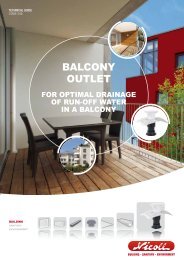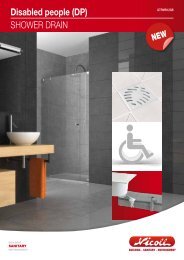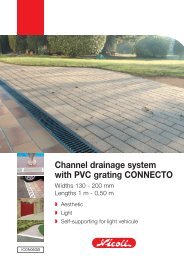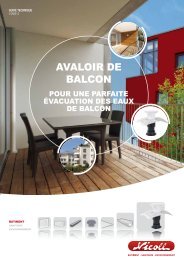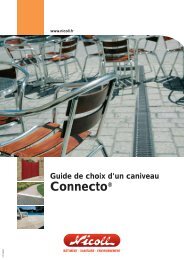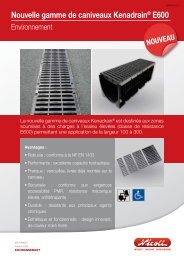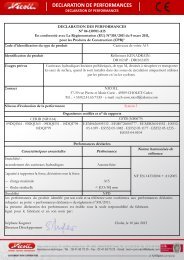waterloc® - Nicoll
waterloc® - Nicoll
waterloc® - Nicoll
You also want an ePaper? Increase the reach of your titles
YUMPU automatically turns print PDFs into web optimized ePapers that Google loves.
www.nicoll.fr<br />
RAINWATER<br />
MANAGEMENT SYSTEM<br />
Specification Guide<br />
waterloc®<br />
ATEC n°17/09-214<br />
14/1-pp-214<br />
Membre FOUNDING fondateur MEMBER<br />
GPWAT12GB
Rainwater drainage is a major challenge.<br />
In our urbanised societies, the ground undergoes systematically waterproofing which prevents<br />
normal infiltration of rainwater. Step by step, this process unbalances the hydrological<br />
mechanism. Today, to limit the progression of this undesirable effect, new strategies for<br />
rainwater drainage have been developed.<br />
As an urban developer, you play a stage-front role.<br />
Drainage networks in our cities do not have enough capacity to handle water run-off entirely.<br />
As such, various urban installations need to directly incorporate hydraulic management into<br />
their design. The new integrated system, perfected by <strong>Nicoll</strong>, meets this requirement. With<br />
Waterloc®, projects can be designed with a high-performance approach to rainwater management,<br />
thanks to unique design on the market.<br />
Take up the challenge and<br />
recommend waterloc®<br />
2
Contents<br />
Rainwater management : the urban context p. 4<br />
Emergence of an integrated approach p. 6<br />
Alternative techniques and SUDS p. 8<br />
Legislative measures p.10<br />
Discover Waterloc ® : high-performance rain water<br />
management p. 11<br />
Take advantage of support from <strong>Nicoll</strong> p. 12<br />
Check out the details on the advantages of the Waterloc ®<br />
system p. 16<br />
Flexibility for all projects p. 18<br />
A global solution p. 19
waterloc®<br />
Rainwater management : understanding<br />
With urbanisation, our ground is<br />
becoming waterproof.<br />
The sharp rise in population density has led to increase large surfaces<br />
for living, traffic and industry. This process of waterproofing the<br />
ground is preventing rain water from infiltrating naturally, which is<br />
increasing the water flow in an alarming manner.<br />
40 %<br />
evapotranspiration<br />
30 %<br />
evapotranspiration<br />
10 % run-off<br />
55 % run-off<br />
25 %<br />
superficial infiltration<br />
10 % superficial infiltration<br />
25 %<br />
deep infiltration<br />
5 %<br />
deep infiltration<br />
Rural areas<br />
Urban areas<br />
4
and controlling the impact of urbanisation.<br />
The consequences are multiple.<br />
Inhabited areas are fragelized<br />
Waterproofing, as well as the reduction of natural areas for flood<br />
infiltration, are making our built-up areas unable to handle high<br />
precipitation situations. By running off directly into the rivers, these<br />
waters amplify flooding phenomena. In order to secure the<br />
infrastructures and building areas, it is essential to minimize these<br />
risks.<br />
The ecological impact is real.<br />
Progressively, the underground water table is going down and ground<br />
is drying out. The natural cycle of water is as such disturbed and in<br />
(turn leads to repercussions.) Furthermore, water flowing over the<br />
ground is contaminated with hydrocarbon : procuring drinking water<br />
becomes complicated and the environment is at threat. This is<br />
essential to reverse this trend as quickly as possible.<br />
Local authorities are facing reorganisation problems.<br />
This context is generating high costs for the municipalities which, in<br />
order to cope, extend their sewage network. Along with this effort<br />
comes extrems ducts dimensioning and increase of maintenance<br />
costs. To overcome this issue, cities must define new strategies that<br />
incorporate drainage, using a diagnostic that is not only complete<br />
but also permanent.<br />
What should be remembered<br />
• The rate of rainwater run-off is reaching<br />
55% in the urban centers<br />
• Consequences :<br />
- increase in the volumes of rainwater run off<br />
- flooding in urban areas<br />
- decrease in the renewal of watertables<br />
- surface water quality degradation<br />
- rising investment and operating costs for<br />
local authorities<br />
• Cities objectives : define integrated<br />
strategies for rainwater drainage.<br />
5
waterloc®<br />
Today, rainwater management is moving<br />
Each area has its own approach to<br />
rainwater management.<br />
In the middle of the 20th century, there were various ways of<br />
approaching rainwater drainage.<br />
1950s<br />
1970s<br />
Hygienist<br />
approach<br />
With this approach, rainwater was considered<br />
to be a source and/or vector of contamination.<br />
Hydraulic<br />
approach<br />
With the expanding urban areas and the<br />
constant increase in waterproofed surfaces,<br />
the saturation of the drainage networks had<br />
to be addressed.<br />
The principle : remove the rainwater far from<br />
the cities, and as quickly as possible.<br />
The principle : separate rainwater from<br />
waste water.<br />
6
towards an integrated approach.<br />
1980s<br />
Today<br />
Maturity age : an integrated approach.<br />
At the dawn of the 21th century, past experiences and our level of<br />
knowledge had led us to combine these 3 historical approaches<br />
and all of their concerns. Rainwater management is now handled<br />
globally and transversally with the engineering and development<br />
disciplines.<br />
Environmentalist<br />
approach<br />
Along with booming ecological awareness, a<br />
new piece of information came to light rainwater<br />
washing dirty surfaces is a source of degradation<br />
for natural environments.<br />
The integrated approach is defining its challenges...<br />
• Favor rainwater management upstream.<br />
• Use the infiltration capacity of the ground and soil as not as<br />
possible.<br />
• Slow down the transfer of water from upstream to downstream.<br />
• Think on a full scale, not only on the project.<br />
• Design urban installations by integrating rainwater drainage.<br />
... and is offering solutions.<br />
In order to support this new view, methods for managing rainwater<br />
other than "all pipes" have appeared : techniques referred to as<br />
"alternative", are also called compensating solutions. These aimed to<br />
attenuate peak flows generated by heavy rainfall and at compensate<br />
the negative effects of waterproofing. This stops the aggravation of<br />
the existing situation and overloads saturated networks, according<br />
to locally-defined flow rates.<br />
The principle : trap and treat the pollution<br />
carried by run-off water.<br />
What you should retain<br />
• The integrated approach combines 3 historical<br />
approaches :<br />
- hygienist<br />
- hydraulic<br />
- environmentalist<br />
• Rainwater management is at the<br />
heart of urban installation issues<br />
• The alternative techniques offer new<br />
perspectives.<br />
7
30 % void<br />
waterloc®<br />
30 % void<br />
Alternative techniques combined with<br />
In an urban context : Alternative<br />
techniques are reaching their limits.<br />
95 % void<br />
Open-air basins, swales, drainage trenches, dry wells, storage on roof,<br />
roads with underground drainage system… Rainwater drainage<br />
techniques have had their applications multiplied over the last few<br />
years. With a double-evacuation 30 % void possibility, either through infiltration<br />
into the ground or into an outlet, these are proven solutions in the<br />
natural environment.<br />
In urban areas however, these techniques<br />
95 % void<br />
used alone are often not<br />
sufficient to handle the complex issues of rainwater drainage.<br />
95 % void<br />
30 % void 95 % void<br />
Open-air basin<br />
Road or basin with an underground drainage<br />
system with stones<br />
30 % void<br />
Swales<br />
Drainage trench<br />
30 % void30 % void<br />
30 % void30 % void<br />
8
<strong>Nicoll</strong> solutions : new perspectives.<br />
The Sustainable Underground Draining<br />
System (SUDS) amplifies capacities and<br />
adds value to the land.<br />
Using this observation as a basis, an additional process has come<br />
to light : SUDS, a reservoir structure consist of stackable plastic<br />
modules, with a high void ratio. These modules are covered on all<br />
sides with a 30 geotextile, % void and in case of watertight structure, with a<br />
membrane.<br />
95 % void<br />
Underground basin with <strong>Nicoll</strong> SUDS<br />
What you should retain<br />
The advantages of SUDS :<br />
30 % void<br />
30 % void<br />
95 % void<br />
30 % void<br />
30 % void<br />
• a high void ratio of 95%<br />
• low resistance to the vertical and<br />
horizontal transfer of water<br />
• modular elements that can be<br />
handled by a man<br />
• high resistance to vertical compression,<br />
for use under roads,<br />
parking areas or infrastructures<br />
Swales with <strong>Nicoll</strong> SUDS<br />
Drainage trench with <strong>Nicoll</strong> SUDS<br />
95 % void 95 % void 95 % void<br />
95 % void<br />
9
Legislation : moving towards sustainable solutions.<br />
Progressively, political measures are coming out.<br />
Laws concerning rainwater management over the last twenty years, have never ceased favouring a better handling of the issue. From<br />
European standpoint as well as local one, decision-makers are aware of the urgency of the situation. Also, the constraints concerning<br />
creating infrastructures and buildings are increasingly strict.<br />
Their objectives are defined over the long term.<br />
All of these legislative references have for purpose to set the framework for a sustainable drainage policy. This consists approving building<br />
permits for urban development ensuring following conditions :<br />
• the quality of service designed for the current and future populations is maintained, in terms of health and public hygiene, risk control<br />
and comfort ;<br />
• the natural environment is preserved and respected ;<br />
• costs are controlled, (investment as well as operating costs)<br />
10
waterloc®<br />
One system, three solutions.<br />
Rainwater regulation.<br />
Objective<br />
Cap the inflow of rain water in sewage by<br />
deferring restitution of the excess run-off water<br />
by providing temporary storage.<br />
Application<br />
In order to offset any negative effects in new<br />
construction or new installation generating<br />
waterproofing.<br />
Rainwater infiltration.<br />
Objective<br />
Cap the inflow of rainwater, by providing<br />
temporary storage of the excess run-off water<br />
and restitute to the natural environment via<br />
infiltration into the surrounding ground (assuming<br />
soil permeability is compatible).<br />
Application<br />
For any new construction or any new installation<br />
generating waterproofing, in order to offset the<br />
negative effects of it or in the event where there is<br />
no public network.<br />
Reuse of rainwater.<br />
Objective<br />
Reuse of rainwater by storing it in order to save<br />
drinking water.<br />
Application<br />
In areas where the use of water is high and is not<br />
required (stadiums, pedestrian areas or green<br />
space, fire water reserves, etc.) Not valid for drink<br />
water.<br />
11
waterloc® With <strong>Nicoll</strong>, benefit from a global<br />
Personalised support all throughout<br />
your project.<br />
In managing rain water, the Waterloc® system stands out not only<br />
because of its performance, but also by the quality of technical service<br />
support.<br />
1 Preliminary project<br />
2<br />
Technical study<br />
<strong>Nicoll</strong> engineers assist local authorities, urban developers,<br />
urban planners and public works companies in gathering<br />
all the information needed to examine a Waterloc ®<br />
solution.<br />
<strong>Nicoll</strong>'s technical-sales department will carry out a<br />
complete study in order to facilitate prescription and<br />
integration of a Waterloc ® solution into the project.<br />
12
solution for rainwater drainage.<br />
Assistance in drawing up an estimate<br />
3 4<br />
Using the study, the exact check list of parts needed<br />
to build the Waterloc ® solution is provided as well as<br />
assistance in obtaining figures for the project : soil<br />
evacuation, backfill, quantities of geotextile and/or<br />
geomembrane.<br />
Assistance during installation<br />
According to countries, the company will receive<br />
a help for installation.<br />
13
waterloc®<br />
A design thought out down to the smallest<br />
Easy-to-handle cells<br />
• Grasping handle allows for handling even when<br />
wearing gloves.<br />
• Light cell (12 kg).<br />
Total volume retention<br />
capacity<br />
>95 %<br />
A unique model<br />
Nestable and stackable : less volume of stock on<br />
the site, and in terms of transportation (reduced<br />
CO 2 emissions).<br />
250<br />
liters<br />
1<br />
2<br />
3<br />
4<br />
14
details.<br />
High resistance :<br />
• to vertical compression (backfill and moving loads)<br />
• to lateral compression (earth pressure)<br />
Geometry and materials chosen for their high resistance<br />
over the long term<br />
Weight of module<br />
13 kg<br />
100 %<br />
Recyclable<br />
benefits<br />
• 250 litre cell (void volume > 95 %)<br />
• Quick and easy to install<br />
• Nesting for easy transportation<br />
• Connectors integrated within the module<br />
• 100 % recyclable<br />
• Small surface area required during work<br />
on site<br />
• Half as many trucks to unload, arrange,<br />
etc.<br />
• Half as many pallets required in the<br />
trench<br />
Minimum height of the covering is specified during the study according to<br />
the traffic conditions and each country curent legislation.<br />
15
waterloc®<br />
A unique design, for optimal performance.<br />
Simple and reliable to assemble<br />
• Base plate.<br />
• Large-size markings,<br />
ensuring proper<br />
stacking<br />
direction.<br />
• Centring snugs around the<br />
entire periphery, which lock<br />
the module in laterally.<br />
Inlet/outlet/vent for the Waterloc ® basin<br />
(Ø 100-110-160-200 mm)<br />
This system allows the geomembrane to be clamped and as such be tight. It also allows for<br />
positioning at any location on the basin.<br />
• Fastening plate on the cell doubles<br />
as a clamping flange.<br />
• Inlet/outlet socket, via simple 180°<br />
rotation (inlet or outlet).<br />
16
Connectors<br />
• Large size: resistant part, easy to assemble, limits the risk of misplacing items...<br />
• Few connectors to install (save time when implementing).<br />
• Small connectors for alignment of<br />
first level cells.<br />
• Top cell connectors only on the last<br />
level of the stack.<br />
17
waterloc®<br />
Flexibility for all projects.<br />
Large diameter socket connections<br />
(315 or 400 mm)<br />
500 L set with PP socket connections with male spigot allowing for<br />
connection to any type of pipe.<br />
Ø 150 mm hydrocurable distributor cell (internal ø)<br />
Cell with PVC drain with a slit on the upper half, making it possible to :<br />
• prevent pollution carried by the washing of the ground from the first rain from penetrating<br />
into the basin<br />
• inspect the drains in order to check that the basin is in good condition<br />
• clean the drains in order to maintain the basin.<br />
Passing the inspection robot<br />
18
waterloc®<br />
A global solution.<br />
Before specifying a Waterloc® solution, several points need to be complied with :<br />
Rainwater pollution treatment process<br />
Pre-treating rainwater upstream of the basin is recommended in order to increase system sustainability.<br />
Basin implementation<br />
Until local requirements exist, basin installation is required as follows :<br />
1- Near buildings, the underground drainage structure must be at least equal to the distance of the depth of the excavation on the<br />
horizontal direction.<br />
2- Separation in terms of trees or bushes should be at least equivalent to the height of the adult plant (except in cases a system is<br />
provided to confine root development).<br />
3- Minimum 5 m separation from the nearest buildings for infiltration application.<br />
4- Infiltration in the presence of an underlying underground water table : a minimum depth of 1 meter is reserved between the highest<br />
level of the table water and the bottom of the infiltration structure.<br />
5- Remember that the excavation is generally clearly wider and longer than the basin itself due to the angle of excavation talus<br />
and the necessity of maintaining a lateral clearing at the end of the trench of about 0.8 to 1 m around the basin in order to work in<br />
good conditions. Passing the inspection robot.<br />
<strong>Nicoll</strong> products in the Environmental Speciality fall in line with the global "SWS" Sustainable Water Solutions approach conducted by<br />
all of the companies in the Aliaxis Group. www.sustainablewatersolutions.com<br />
19
www.nicoll.fr<br />
Sanitary<br />
<strong>Nicoll</strong><br />
also leads<br />
to serenity<br />
Environment<br />
Building<br />
PAO <strong>Nicoll</strong> - Février 2012- Photo credits : <strong>Nicoll</strong> - Non-contractual document<br />
Head office and Plants : 37, rue Pierre & Marie Curie - BP 10966 - 49309 CHOLET Cedex // Tél. 02 41 63 73 83 - Fax 02 41 63 73 57<br />
Documentation request : info@nicoll.fr // Technical request : tech-com.nicoll@aliaxis.com<br />
with a capital of 7 683 431 e - 060 200 128 RCS Angers



